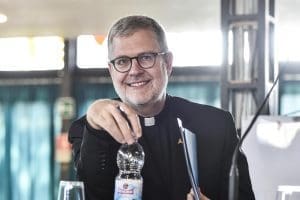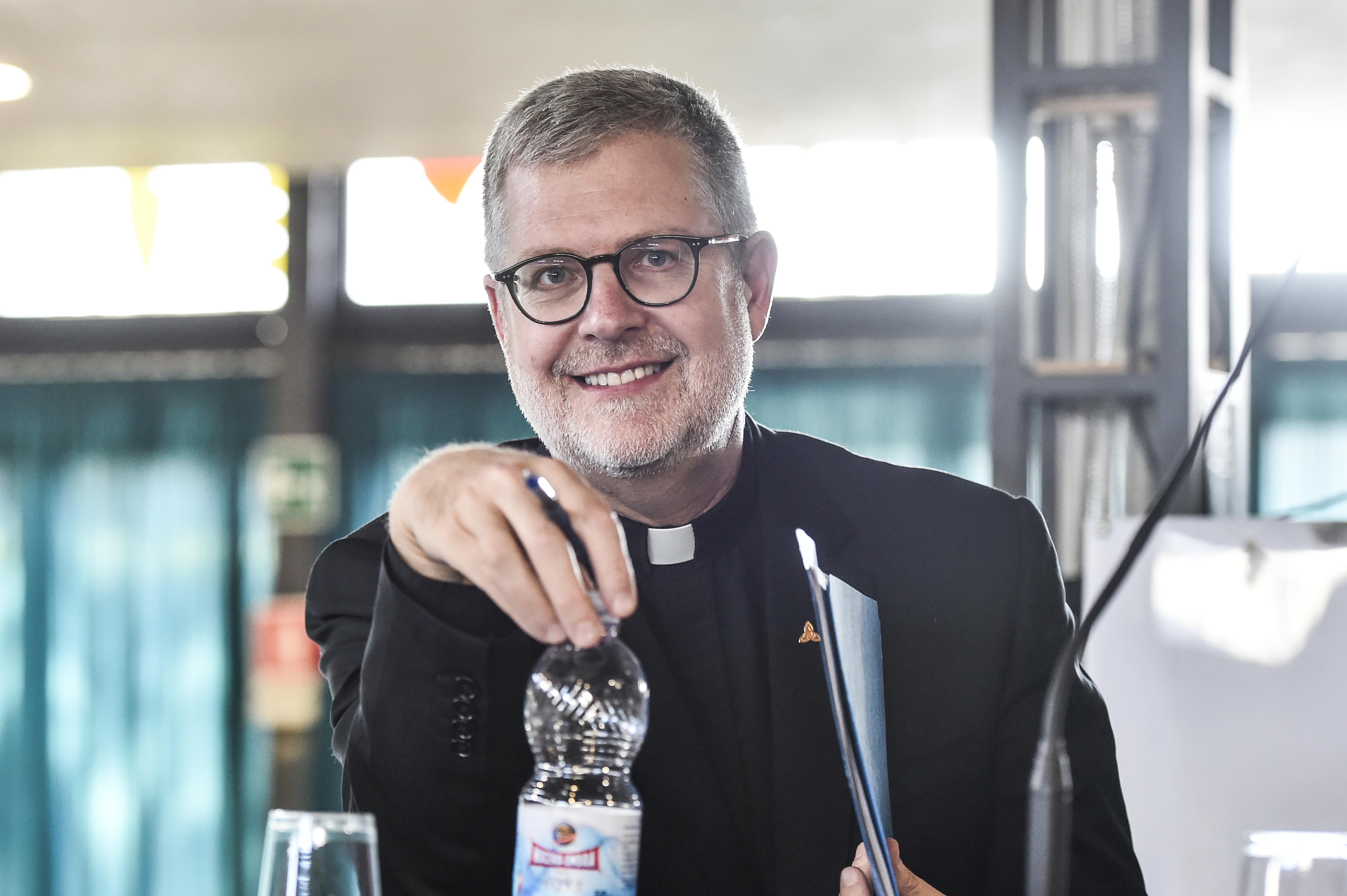From here to where?
 By Rev. Dennis H. Holtschneider, CM
By Rev. Dennis H. Holtschneider, CM
I’ve been given a title today called “FROM HERE TO WHERE?” As I understand it, the idea is to provoke some thinking about what’s next as we begin our fifth century attending to the needs of the poor.
Let’s start with the obvious. Our work has been changing almost since St. Vincent started it.
- In my Congregation, Vincent loved his Tuesday afternoon conferences for the clergy, but he had no interest in seminaries whatsoever. That was until the bishops started asking him and then assigning the Congregation the smaller and more rural seminaries, which he saw as a chance to educate priests for the poor and rural populations.
- Vincent was against ever taking charge parishes. He wanted his priests to be free for the missions they were giving across France. But again, bishops insisted and the priests in the Congregation began to age. Vincent realized he needed a place for the older priests who couldn’t travel easily to work, and so parish ministry was begun in his lifetime.
- Vincent thought that the mission to Madagascar was the “crown in the jewel.” Soon after his death, however, Fr. Almeras, his successor as superior general, pulled the Vincentians out.
- That same generation after Vincent was also presented with a request from Queen Anne of Austria herself to staff Fontainebleau Palace, which then led to the same at Versailles, which led to Vincentians being named bishops. Suddenly, the Vincentians were enmeshed in circles of royalty and power rather than the work Vincent had started. Was that a misstep? It was a wrenching question at the time. History suggests that it strengthened the finances and political connections of the Vincentians after St. Vincent was no longer there to do it himself, ensuring the work for the poor would continue.
- The Daughters were founded to serve the Ladies of Charity, but they eventually took on their own works.
- The Ladies of Charity were designed to be localized without a central governing body, but as soon as they were reestablished after the French Revolution, they developed a strong central governing body which has made them the largest women’s organization in the Church. They also focused with a new intentionality on poor women, which gave Ozanam room to reclaim the original parish-based idea to serve poor families.
At every turn – and from nearly the very beginnings of all of our Vincentian families – we’ve changed. Whether the world around us forced it, or whether we discovered new needs and better ways to serve those needs, we’ve changed. Constantly. For 400 years. It should be no surprise then if this gathering – 400 years later – is focused on what’s next.
I’m not here to predict things. But I would like to suggest that the world still needs us to change, and perhaps even to suggest some larger changes we might adopt as we find our way from “Here to Where.”
Thankfully, according to the World Bank’s best estimates, the world has cut “extreme poverty” within the world’s population in the last 50 years from 40% to under 10 percent. There are 1 billion less poor people today than in the 1970’s, by that definition.[1] Admittedly, “extreme poverty” is an extreme measure. It equals about $1.90 a day, barely the minimum to feed and clothe oneself in the poorest countries. Few, if anyone, in the U.S. or Europe are poor enough to fall under that definition. Happily, though, the trend is consistent even under more expansive measures of poverty. The percentage of the world living in poverty is going down, and that’s very good news.[2]
But localized poverty in every nation still exists. Africa as a continent is particularly challenged when it comes to making progress similar to that of Asia. Numerous regions of the world are still held back by war, government corruption, economic greed, and now the effects global climate change wreaking havoc on farming and land masses on which the poor traditionally build their homes. We have made progress, but by any measure, human misery abounds and still requires the world’s care and attention. St. Vincent’s heart for the poor remains dearly needed.
The long-term solutions, of course, are still rule of law, rudimentary healthcare, effective farming, basic education (especially of women), government safety net programs, and yes, strong economies lifting all boats, including those of the poor. And while governments and NGO’s are often better suited to address largescale initiatives over time, the needs of the poor right now, today, require today’s attentions and assistance. Traditionally, that’s where we’ve been attentive and helpful.
There will always be a need to assist the elderly women down the street who did not eat yesterday, or the young man forced to join a gang in order to survive on the street. Charity has its place and its good effects. Like the gospel story, we must always be attentive to the poor at our gates. I am convinced, however, that in the midst of serving the individual needs of the poor at our gates, the Vincentian Family can do MORE, and we can do it MORE EFFECTIVELY. For that is my answer to the question, “From Here to Where?” My answer is simply “More, and more effectively.”
How? Allow me to suggest 5 ways.
- We need to work together as a Vincentian Family. Seven years ago, Fr. Gregory Gay, our former Superior General, invited Mark McGreevy from London and others to address the General Assembly of Vincentian priests and brothers because he wanted to expose us to what he thought were particularly creative examples of the Vincentian tradition growing in our midst. I don’t know anyone else’s reaction that day, but it grabbed my imagination and I ask Mark if we could talk. That talk cost me dearly. He roped me into the project in ways I couldn’t have imagined. Mark’s good at that. He’s good at roping people the way that cowboys rope cows. In the U.S., the Daughters of Charity are deeply involved in Depaul International’s works. Vincentian priests have been roped onto his board, and then asked to join him to train his staff worldwide in the life and spirituality of St. Vincent. Mark is successful because he’s Mark. He’s successful because the many people he’s recruited to work with him from all walks of life in seven countries, and soon many more. He’s also successful because he successfully roped the Daughters of Charity and a few of us priests and brothers to join him.
That’s the model we should employ all the time. The AIS has extraordinary reach, but the Daughters have deep knowledge of social services, healthcare and education, and extraordinary connections to institutions. The Vincentian priests and brothers have a wonderful spirituality born of their work with the poor and their considerable training. They too have extraordinary resources through their universities. The Society of St. Vincent de Paul has our deepest day-to-day knowledge of the poor across the world. They know the poor firsthand as well as any of us, and can mine and distribute that knowledge if they so choose for all of our benefits. Few of our members know the young exceptionally well, but the members of the Marian Youth do.
Who knows what we could do together! I only know that Depaul International would not be the institution it became if Mark hadn’t met a Daughter of Charity in London at the very outset. We need to work together as a Vincentian Family.
- We also need to work with others. It’s a mistake to ask, “What can we do with our current resources?” We should ask the big question: “What do the poor need?” and then start thinking creatively about with whom we should partner.
18 years ago, the Daughters of Charity and Sisters of St. Joseph in the U.S. did an incredibly brave and selfless thing. They literally handed over all of their healthcare works – everything –
the hospitals, the nursing homes, the clinics, the doctors’ practices. Everything. For free. They didn’t get a dollar for all that land. All those buildings. All those value health systems. The next year, the Sisters of St. Joseph of Carondelet joined them and did the same. The Alexian Brothers followed suit. The Marian Sisters. The Wheaton Franciscans. More Catholic hospitals and religious congregations followed. Why did they do it? They knew they could serve more people, more effectively and more sustainably if they created a new organization of everyone, instead of holding tightly to what they had built themselves.
Today, Ascension is the largest health system in the United States, and the world’s largest Catholic health system. It continues to grow and to transform and to seek partnerships with anyone who believes in the work of continuing the healing ministry of Jesus Christ. All of that because the sisters chose to let go of individual control, and to work together.
Back in 2011, John Kania and Mark Kramer published a seminal article in the Stanford Social Innovation Review called “Collective Impact.”[3] In it, they spoke of partnerships as not being enough. What’s needed for true social impact, they discovered, was partnerships where (1) everyone who needed to be at the table was at the table; (2) where a common agenda was forged; (3) where individual organizations were willing to let go of control, adjust their own work so that the whole project could be successful, and even accept very specific assignments from the whole; (4) where people were willing to measure not only accomplishment, but all the key components that would eventually contribute or hinder that success; (5) where everyone involved was in constant communication so that activity could remain aligned and coordinated, (6) where a very strong and smart “backbone” organization drove all the activity, and (7) where everyone agrees that they will learn along the way and adapt the work based on what they learn.
That article is changing philanthropy in the United States, and encouraging broad coalitions in cities and elsewhere to come together to undertake large, complicated social goals. No single group ever had a prayer of addressing school reform, or environmental change or poverty. But together, collective impact is showing promise.[4] Collective Impact is far more than simply partnering. It’s a new way of working together to achieve very big goals, and I believe it holds great promise of organizations like ours as we take stock at 400 years and ask “From Here to Where?” Imagine if the Vincentian Family worked closely with Caritas. Imagine if we took on projects for and with the UN, the WorldBank, the Gates Foundation, and more. They all have great resources and sophisticated knowledge, but we have something they do not: Reach. We know the poor personally. The poor trust us. We can bring firsthand knowledge to the design of largescale reform, and we can create conduits for delivery of that reform. We need to work with others more extensively and more effectively outside of our Vincentian Family if we are to achieve our goals and the Collective Impact literature offers us a path and encouragement.
Which leads me to my third point:
- We need to work smarter. I’ve spent my life working in universities. I loved speaking with faculty. It made my day when I’d ask a faculty member about his or her field of study or research and then watch their faces light up when they realized I was genuinely interested. They LOVED what they were learning. They LOVED seeing old knowledge give way to new ideas that just worked better than the old ones. They LOVED being part of an intellectual enterprise that focused on how to improve the world – whether it was science, or child development, or international finance, or human rights law, or the arts. The faculty learned constantly – whether on online blogs, or journals, or books. If you scratched past the intellectual mien, you could find the child inside that delighted in books when they were young.
But my new job in healthcare makes university faculty seem tame by comparison. In healthcare, most every conversation is about how we could change based on something that was announced the day before. A treatment protocol; a new way of cleaning facilities; a more efficient use of computers in our work; a change in legal regulations. People read twice a day in healthcare, if not more often.
That should be true of us too. The Vincentian Family should be reading the social impact literature; the amazing research on poverty; on homelessness; on creative ideas being deployed in other countries than our own. You get the idea. There’s so much there to learn from and to think more creatively from. If I have conversations about what people are learning and reading in higher education and healthcare, I rarely have conversations like that among ourselves. I’m not sure we’re up-to-speed on what’s been written and learned about the best ways to address poverty. Even more, I’m not sure we choose leadership for that reason.
Make no mistake, I’m edified and inspired by the leaders I’ve met in the Society, the AIC, the Marian Youth, the Daughters, the Sisters of Charity and Congregation. But few of them were chosen because they were acknowledged broadly as expert in poverty-relief. In actuality, we don’t need to choose leaders that way, but we should at least hire world-class experts into our organizations, either as full-time employees, consultants, or advisory boards. It’s time to incorporate the best and latest research that’s been done. We know the poor – that’s true. And that’s unbelievably valuable. But there’s more to learn, and my hope for the Family is that we will work even smarter going forward. The poor deserve more than good-hearted amateurs. They deserve experts.
On that note, let me suggest one very specific contribution we can make to the world if we decide to, and this one’s easy:
- We need to inspire others’ hearts to care about the poor. Most all of us know poor people, and by name. We know their struggles. We know how those struggles have changed over time. We know how so many things get in the way of them raising their lives. We need to tell those stories. To everyone we know. However and wherever we can.
Part of what holds the poor back is that ordinary people have absolutely no idea about the poor’s lives. They don’t know that the primary factor putting women and children in poverty is divorce. They don’t know how bad the innercity schools are. They don’t know that the government-prescribed minimum wage in the U.S. doesn’t let people buy food, shelter and healthcare, so people have to choose among them any given month.
We know these stories and these struggles, and people listen to us. We have nothing to gain and therefore our voice is credible. We MUST speak. Silence dooms the poor to more of the same treatment by society. We MUST speak. And we must use the new tools at our disposal. It’s so much easier on social media to tell our stories. We don’t have to use names. WE can protect the confidentiality of the poor and still tell their stories, so that the rest of society becomes more sympathetic, and therefore more helpful.
We MUST speak what we know. The world does not presently know us. We are NOT a collective voice in the world’s consciousness. We MUST figure out how to make what we know known. We need to inspire others’ hearts to care about the poor.
- Finally, we need to make sure our tradition is passed on. We need to be communities of invitation, inviting the young to visit the poor with us, to see our commitments. My experience, though, is that we only recruit for ourselves. Each branch recruiting for our own branch. We need to start recruiting for each other, not just for our individual organizations. A Vincentian Family recruiting for the entire Vincentian Family.
Even more, we need to make sure the Vincentian charism itself is passed on. All of us have our ways of teaching the “new ones” about St. Vincent, St. Louise and our other Founders. That story-telling has been made possible all these years by actual historians. Men and women – predominantly priests and sisters – who learned the original languages, read all that has been written by those who came before us, and earned graduate degrees in history so they understood the context of the time and thereby understood the Vincentian contribution. Those historians have been a magnificent gift to us, and whether or not any of us ever had the honor of hearing them speak, those who DID tell us our history relied on THEIR writings, THEIR translations, THEIR mentoring and training, THEIR tours of Paris. Those historians have not been many, but they have been a critical link for us. We must make certain that there are historians for the future, and those historians will not likely be priests or sisters. For the next hundred years, it becomes the responsibility of the Vincentian lay organizations to train, hire and fund historians. We don’t need many at any given time, but we need a few at all times, and hopefully able to speak the various languages that our members use.
The exact same is true for experts in Vincentian Spirituality. Who will inspire us and form our spirits in the century ahead? These could be priests, brothers and sisters. They could also be lay. What matters is that they are trained, and trained well. We need a plan there too. Perhaps like the story of “The Last Jedi” in Star Wars, new Jedi – Vincentian experts – will just appear, but we can’t count on it. We need a plan.
We are privileged to bear and continue the love that Jesus Christ had for the poor. His heart for them was our founders’ heart for them, and for these years it’s our turn to bear this heart for the poor. I’m proud and grateful to have been introduced and brought into this 400-year project for the world’s poor. If I’m worried at 400, it’s because I worry that we’re so busy doing the activity we’ve been assigned, that we’re not very creative at this moment and even somewhat isolated from the rest of the world’s work for the poor.
Most people in the Vincentian family pick up the work where others left it, and continue it. They adjust things in small ways as needed, of course, but by and large they provide continuity of service for people badly in need of our service. Somewhere along the way, of course, someone “invented” these paths most of us follow. There was a first person in our jobs, and a founder of our works. God bless those individuals, because there’s lots of uncertainty and risk in starting something new – and no small amount of work. That’s what’s being asked of us today. We’re being asked to break open a new path so that the Vincentians who follow us can continue to work in a new way.
From Here to Where? I can’t predict our future. But I know our future needs us to work together as a Family, to work with others outside the Family, to work smarter, to inspire hearts for the poor, to make certain we know who we are in our Vincentian history and our Vincentian spirituality. If we can rise to those, and be unafraid of change, I know our fifth century is going to be a true blessing for the poor.
Thank you for everything you do for the poor and for each other. God bless you for your good hearts, and God bless our Vincentian Family.
Thank you.
To get the document in PDF, click on the next link: From here to where?
[1] “Fewer, But Still with Us: The world has made great progress in eradicating extreme poverty.” The Economist, March 30, 2017.
[2] “Qui, Linda. “Did we really reduce extreme poverty by half in 30 years?” PolitiFact Global News Service, March 23, 2017.
[3] Kania, John and Kramer, Mark. “Collective Impact,” Stanford Social Innovation Review, Winter 2011.
[4] “Collective Insights on Collective Impact.” http://collectiveinsights.ssireview.org/.
Tags: Famvin400, Fr. Dennis Holtschneider, Speakers, Symposium




Excellent advice to follow in all our vincentian settings